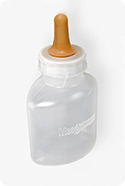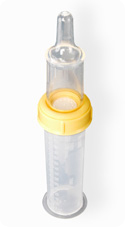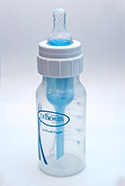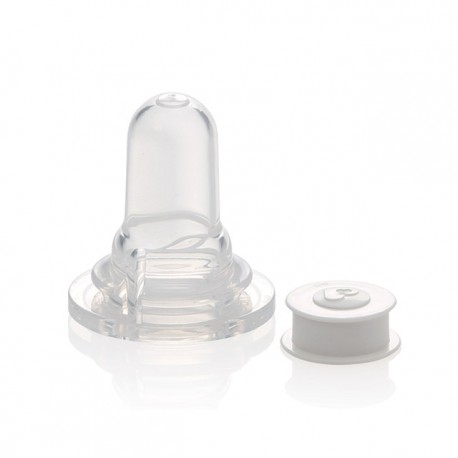Appropriate Feeding Techniques for Cleft Palate
Patient and Family Resources
Cleft Feeding Instructions
Why do babies with clefts have problems with feeding?
Babies with clefts have trouble with feeding because it changes how parts of the mouth are formed and how they work and fit together.
- Cleft lip makes it hard for babies to make a good seal around the nipple.
- Cleft palate makes it hard to create suction because the mouth cannot be closed off from the nose.
Normally, a baby pulls the nipple into their mouth and makes a seal with the lips around the nipple. When the baby sucks and swallows, the back of the roof of their mouth (soft palate) rises up and closes off the mouth from the nose. This creates suction and holds the breast or bottle nipple in the mouth, and the baby sucks to draw out milk.
How do I feed my baby with cleft lip?
Babies with only cleft lip can usually be fed by breast or regular bottle. Our nurses and infant-feeding specialists can help you make sure your baby gets a tight seal around the nipple.
Breast-feeding
- During breast-feeding, the soft breast tissue often will fill the opening in the lip and/or gum line. This seals off the mouth and lets your baby create enough suction.
- Sometimes it helps to hold a finger across the cleft while your baby feeds.
- Swallowing noises and normal weight gain are signs that breast-feeding is going well.
- If your baby is "noisy" with feeding, making clicking or kissing noises, they may not have enough suction.
Bottle-feeding
- If you bottle-feed your baby, feeding may work better using special bottles or nipples with a wider base.
- When starting a feeding, hold your baby in a slightly upright position.
- Touch the baby's lower lip with the nipple.
- When the baby latches on, direct the nipple slightly downwards.
- Try to keep the nipple in the center of the baby's mouth. Do not let it slip up into the cleft.
How do I feed my baby with cleft palate?
Babies with cleft palate usually need special bottles and techniques to feed well, whether or not they have cleft lip. It is rarely possible to breast-feed or use a regular bottle.
With cleft palate, a baby cannot create suction to get milk out of the breast or bottle.
A baby who is put to the breast may look like they are latching on and sucking well. But they are using up energy and getting little or no milk.
If you planned to breast-feed, we encourage you to express your milk and feed your baby using a special bottle.
Breast milk is considered the most ideal food for all babies. There are added benefits for babies with cleft palate, such as fewer middle ear infections.
Often, mothers who were looking forward to breast-feeding feel great sadness at the loss of this experience. We encourage you to acknowledge this loss and seek support. We can help with feeding techniques to help you maintain closeness with your baby.
What kind of bottle should I use for feeding with cleft palate?
There are 4 types of bottles for feeding babies with clefts:
- Cleft Lip/Palate Nurser by Mead Johnson
- SpecialNeeds Feeder by Medela
- Pigeon feeder with one-way valve
- Dr. Brown's Specialty Feeding System with one-way valve
The Pigeon nipple with one-way valve can be used with any bottle.
The Cleft Palate Foundation website has a video on feeding your baby and information on how to order supplies online.
Cleft Lip/Palate Nurser by Mead Johnson
 Cleft Lip/Palate Nurser
Cleft Lip/Palate Nurser
by Mead Johnson
The Cleft Lip/Palate Nurser by Mead Johnson is a low-cost, soft, squeezable bottle.
We suggest that you replace the long yellow nipple that comes with the bottle. Use any shorter, softer nipple.
- Before using the bottle for the first time, put some water in it and practice squeezing the liquid out of the nipple. This will help you get a feel for how firmly you need to squeeze.
- When you squeeze the bottle, the liquid should flow easily but not too fast.
- As your baby begins to suck, squeeze the bottle with a firm, steady pressure to the count of "squ-e-e-ze-2, 3." Relax your squeeze on the 2, 3 count. This pauses the flow of milk.
- You should only squeeze when your baby is sucking. Watch your baby closely and listen for swallowing sounds.
- If your baby pauses to breathe, you should pause also. If your baby is getting milk out of the bottle, you should see air bubbles in the milk.
- If you forget to stop squeezing the bottle when your baby pauses, your baby may cough and sputter. Just take the nipple out of the baby's mouth for a moment and let them settle. Then continue feeding.
If sputtering happens throughout the feeding, call the Craniofacial team for advice: 206-987-2208. Most parents quickly learn to adjust squeezing to their baby's sucking rhythm.
SpecialNeeds Feeder
 SpecialNeeds Feeder
SpecialNeeds Feeder
The SpecialNeeds Feeder by Medela has a one-way valve that keeps milk in the nipple. It does not require suction.
This bottle used to be called the Haberman feeder.
Sometimes babies can get milk from this feeder themselves by pushing the nipple against their gum line. The nipple is soft-sided. For many babies, it works best for the parent to squeeze the bottle to match their baby's rhythm of sucking and swallowing (as described earlier for the Mead Johnson nurser).
There is a "Y" cut in the nipple. Turning the nipple in the baby's mouth changes the orientation of the "Y" cut in the baby's mouth. This varies the rate of flow. The nipple has 3 lines that indicate which flow rate is in effect.
Dr. Brown's Specialty Feeding System with one-way valve
 Dr. Brown's Specialty
Dr. Brown's Specialty
Feeding System
You can buy Dr. Brown's Specialty Feeding System with one-way valve through Amazon. The Dr. Brown's bottles sold in stores donot have the one-way valve.
Dr. Brown's Specialty Feeding System uses a bottle with a one-way valve at the base of the nipple to keep the nipple full of milk. It does not require suction.
- When the baby bites or compresses the nipple, milk flows into their mouth and not back into the bottle.
- The one-way valve ensures that there is always milk in the nipple.
- The baby controls the rate of the feeding.
Pigeon feeder
 Pigeon nipple with one-way valve
Pigeon nipple with one-way valve
The Pigeon feeder has a nipple with a one-way valve. The nipple can be used with any bottle.
The nipple comes in 2 sizes. The smaller size has a slower flow. It is best for newborns.
The larger, faster-flowing nipple works well for babies 6 weeks and older.
The Pigeon nipple with one-way valve works by compression only. No squeezing is needed.
- A plastic one-way valve that fits into the nipple keeps milk in the nipple. Place the valve with the flat side toward the tip of the nipple.
- When your baby begins to suck, milk flows easily. Your baby controls the flow of milk.
- The nipple has a firm side that goes against your baby's gum line and a softer side that goes on their tongue.
- A small notch near the rim of the nipple serves as an air vent. This notch should be under your baby's nose when feeding. This puts the nipple correctly in your baby's mouth.
- Tightening the nipple slows the flow of milk. Loosening it makes the flow faster.
- If the nipple collapses, loosen and retighten it.
The Cleft Palate Foundation website has information on how to order these supplies online.
How do I care for the bottles and nipples?
All of these bottles and nipples can be hand washed in hot soapy water. Rinse and allow to air dry.
Do not boil the bottles or parts. Do not wash them in the dishwasher or put them in a microwave. They may soften and start to leak.
How do I express breast milk for my baby?
If you want toexpress breast milk for your baby, we recommend a hospital-grade electric breast pump with a double pumping system.
Birth hospitals have pumps for mothers to use in the hospital. You can rent or buy a breast pump for use at home. Insurance can cover rental or purchase of a breast pump for a baby with a cleft palate.
At first, pump at least 8 times in 24 hours, including at least once during the night. After several weeks of frequent pumping, most mothers make enough milk by pumping about 6 times a day. Tips for pumping breast milk (PDF).
How much should my baby eat?
Newborn babies begin with frequent feedings of very small amounts of milk (1 ounce or less). Over time, they increase the amount they can take.
By 2 weeks of age, a baby needs at least 2 to 2.5 ounces of milk per pound of weight each day. For example, a 3-week old baby who weighs 9 pounds should have at least 18 to 22.5 ounces of breast milk or formula in 24 hours.
A feeding session should take no longer than 30 minutes. If it takes longer, your baby is working too hard and burning calories needed for growth.
We recommend weighing babies weekly until they show a normal rate of growth. Usually this happens in 4 to 6 weeks.
How often does my baby need to eat?
During the first month of life, a baby will feed 8 to 12 times per day — every 2 to 3 hours. A baby this young usually feeds at least 2 times during the night.
At 2 to 4 months, a baby will feed 6 to 8 times per day — every 3 to 4 hours.
How will I know if my baby is gaining enough weight?
A baby usually loses weight the first week of life. The loss is usually 5% to 10% of their body weight. Your baby should regain this weight by 2 weeks old.
At first, we expect your baby to gain 5 to 7 ounces per week. At 4 to 6 months old, the rate of weight gain slows. Your baby should gain about 3.5 to 4.5 ounces per week.
What if my baby is not gaining enough weight?
Sometimes babies with cleft lip and palate have difficulties taking enough breast milk or formula to grow.
Ask your medical team for advice. They can give you an approved recipe for adding formula powder to breast milk or regular formula. This gives your baby extra calories, protein and vitamins. Talk to your healthcare team before doing this.
What about starting solid foods?
Babies with clefts can start solid foods at the same age as other babies. Most often, this is at 4 to 6 months.
Experiment to find the right consistency for solids. It needs to be just right so your baby can eat without the food coming out their nose. This is not harmful to your baby. Sneezing will usually clear the food out of the nose. Most babies learn quickly to get the food down their throats rather than out their noses.
Can my baby drink from a cup?
Cup feeding can also be started at the usual age, 8 to 12 months. Cups with plain lids can help limit spills. Do not use spill-proof cups with valves. These require that baby create suction to get any fluid.
See the Cleft Palate Foundation website for a video on feeding your baby and information on how to order supplies online.
Source: https://www.seattlechildrens.org/clinics/craniofacial/patient-family-resources/cleft-feeding-instructions/
0 Response to "Appropriate Feeding Techniques for Cleft Palate"
Post a Comment